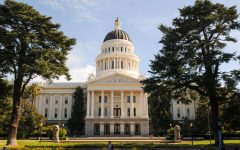
California State Capitol. (Photo: Kevin Sanders for California Globe)
Frequently Asked Questions about Enrolled Bill Reports and Gubernatorial Action
Why does the Office of Legislative Counsel submit an Enrolled Bill Report?
By Chris Micheli, March 29, 2024 2:56 am
What is an Enrolled Bill Report? The Enrolled Bill Report (most often referred to as an “EBR”) is the analysis of a bill with information and a recommendation for final action by the Governor.
Is an EBR confidential? While agency or department bill analyses, including those issued by the Department of Finance (DOF), can become a matter of public record once they have been approved for distribution by the Governor’s Office, the EBRs remain confidential as private communications with the Governor, and they are not subject to release under the Public Records Act.
When is an EBR produced? Once an enrolled bill reaches the Governor’s Desk for final action, “enrolled bill reports” are produced for the Governor and his or her senior staff to consider the merits of a bill pending on his or her Desk.
What is an enrolled bill? An “enrolled bill” is the final version of the bill that has passed both houses of the Legislature and is pending action by the Governor. California’s Governor has three choices with a bill that reaches his or her Desk: sign the bill; veto the bill; or, allow the bill to become law without his or her signature.
For which legislative measures are EBRs produced? EBRs are prepared for bills, but not for constitutional amendments or resolutions (including concurrent, joint or individual house resolutions) because these measures are not acted upon by the Governor.
Who produces an EBR? Generally, there are three EBRs prepared for the Governor’s review: Department of Finance (DOF), the relevant agency that has jurisdiction over the subject matter of the bill, and Legislative Counsel.
What is usually contained in a DOF EBR? Although DOF’s focus is primarily fiscal in nature, occasionally the DOF does raise policy concerns with a bill. In terms of bill analyses versus EBRs, the general rule is that, for bills that were opposed during the legislative process, the DOF’s EBR recommends a veto of the bill. On the other hand, if the DOF supported a bill during the process, then its recommendation in the EBR is usually to sign the measure. DOF can also take a neutral position on a bill and not recommend a signature or a veto.
What is usually contained in a state agency EBR? The relevant state agency (and department) makes a recommendation in its EBR submitted to the Governor’s Office. In most circumstances, the department, board or commission that has jurisdiction over a bill’s subject matter or the department which is directly or indirectly impacted by the bill’s provisions will submit an EBR. Naturally, the Governor and staff want to understand the regulator’s view of the bill and how it would impact their program.
Why does the Office of Legislative Counsel submit an EBR? OLC may prepare an EBR for a bill that the Legislature sends to the Governor to, among other things, identify any conflicts between the bill and any other bills passed by the Legislature in the same Legislative Session. This is done to ensure that later enacted bills do not “chapter out” earlier enacted bills. So, for example, the Legislative Counsel’s EBR may recommend the order in which the Governor signs bills affecting the same code section(s). This EBR addresses the technical aspects of the bill for the benefit of the Governor and his or her staff.
- General Provisions Related to Family Law Support - December 13, 2025
- Petitions for Forming Harbor Districts in California - December 12, 2025
- Child Support Obligations - December 12, 2025




